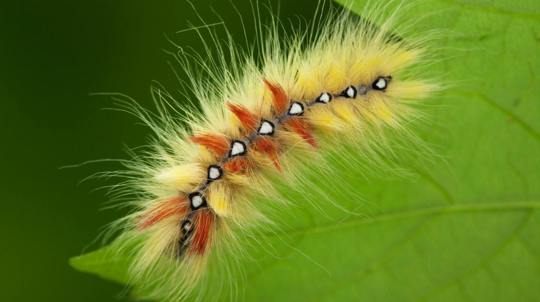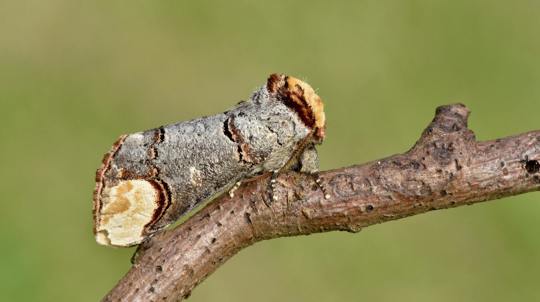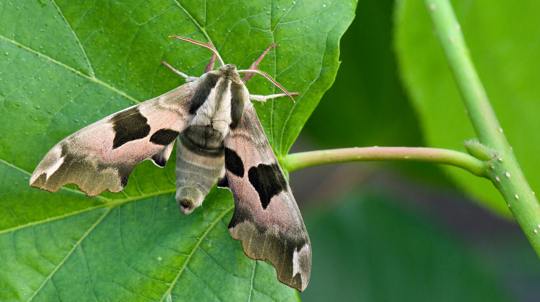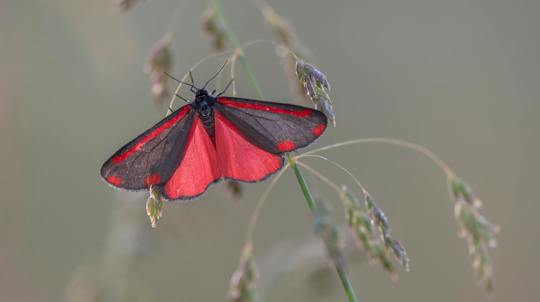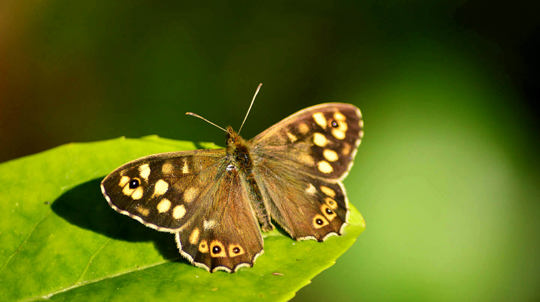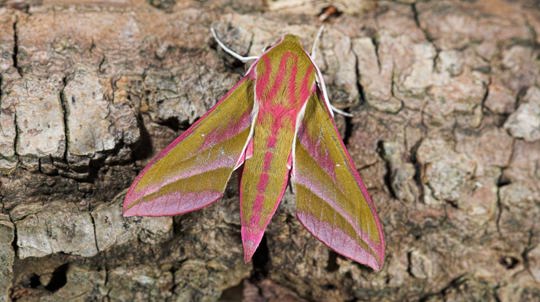These caterpillars are a favourite food of cuckoos.
Hairy caterpillar identification: 16 common UK species

Content manager
Spotted a furry caterpillar undulating across the path in front of you or munching leaves in your garden? Learn to tell your tussocks from your tigers with our quick guide to some common UK species.
1. Garden tiger moth caterpillar (Arctia caja)
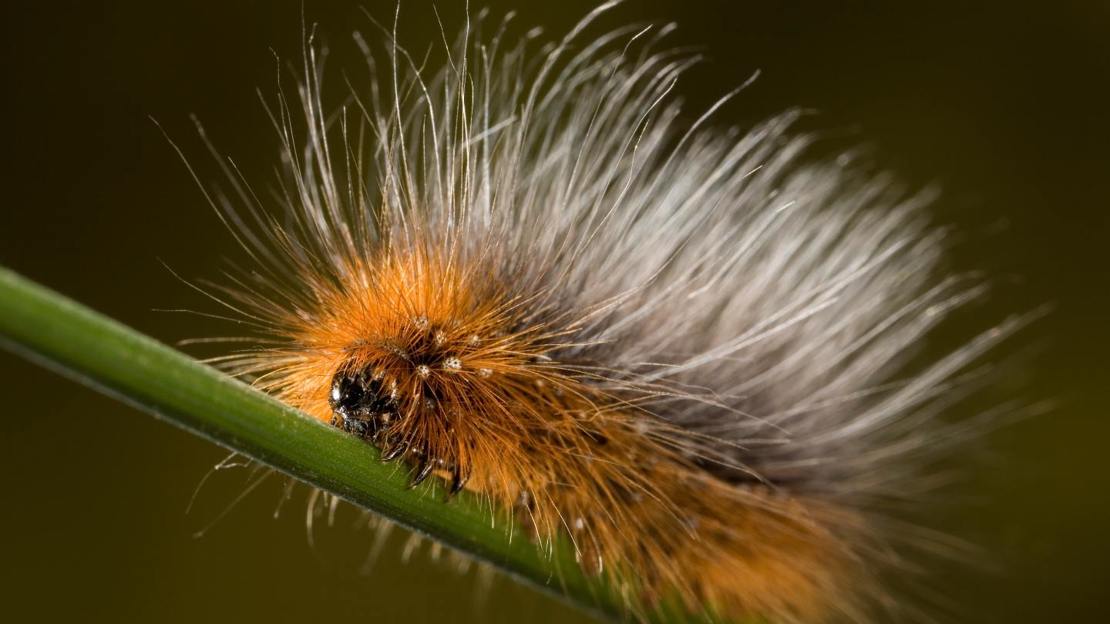
How to identify
This caterpillar is also known as the woolly bear - for good reason! It has a dense coat of long hairs all over its body. The hairs are chestnut brown on the sides and white along the back, turning black closer to the body.
Size
Up to 60mm in length when fully grown.
When to see it
Look out for this caterpillar from August.
Where to find it
Common and widespread across the UK, including in gardens, woodland, fens and meadows. Often spotted moving quickly over bare ground once mature as the caterpillar looks for somewhere to pupate.
Foodplants
Dead-nettles, plantains, docks and other low-growing herbaceous plants.
2. Fox moth caterpillar (Macrothylacia rubi)
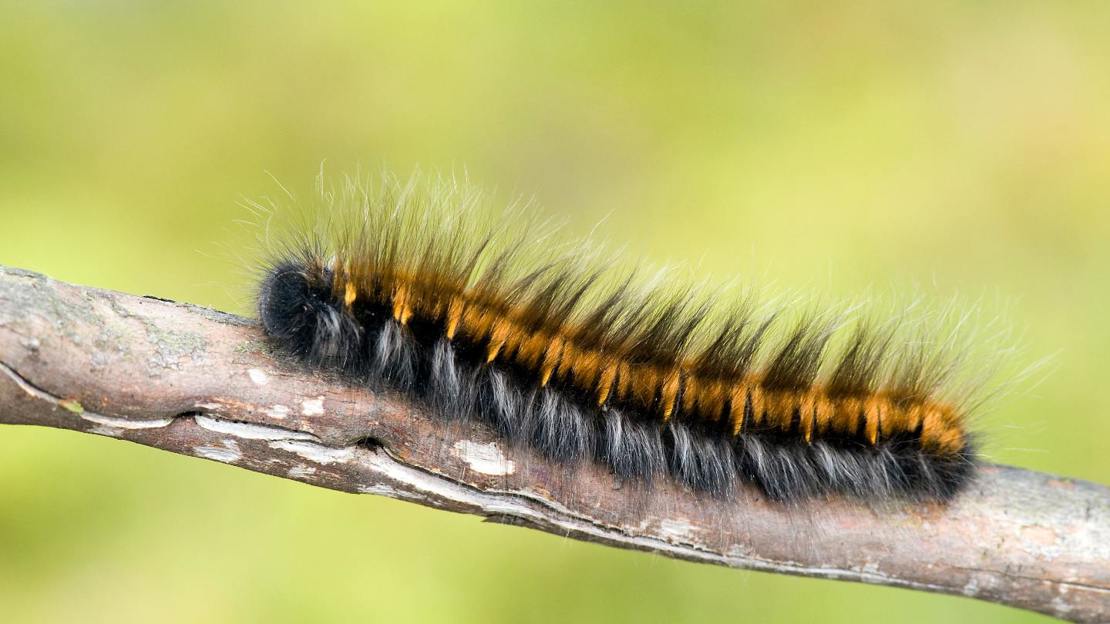
How to identify
Another long-haired, furry looking caterpillar. Look for almost black hairs along the sides and shorter, orange-brown hairs along the back. Immature caterpillars are mainly black with yellow bands across the body.
Size
Up to 70mm in length when fully grown.
When to see it
Look out for this caterpillar from July. Mature caterpillars might also be spotted in April just after emerging from hibernation, when they bask in the sun before pupating.
Where to find it
Widespread and fairly common across the UK. Can be found on grassland habitats including downland and grassy coastal areas, as well as on heathland and moorland.
Foodplants
Bramble, billberry, heather, sallows, meadowsweet and salad burnet.
3. Oak eggar moth caterpillar (Lasiocampa quercus)
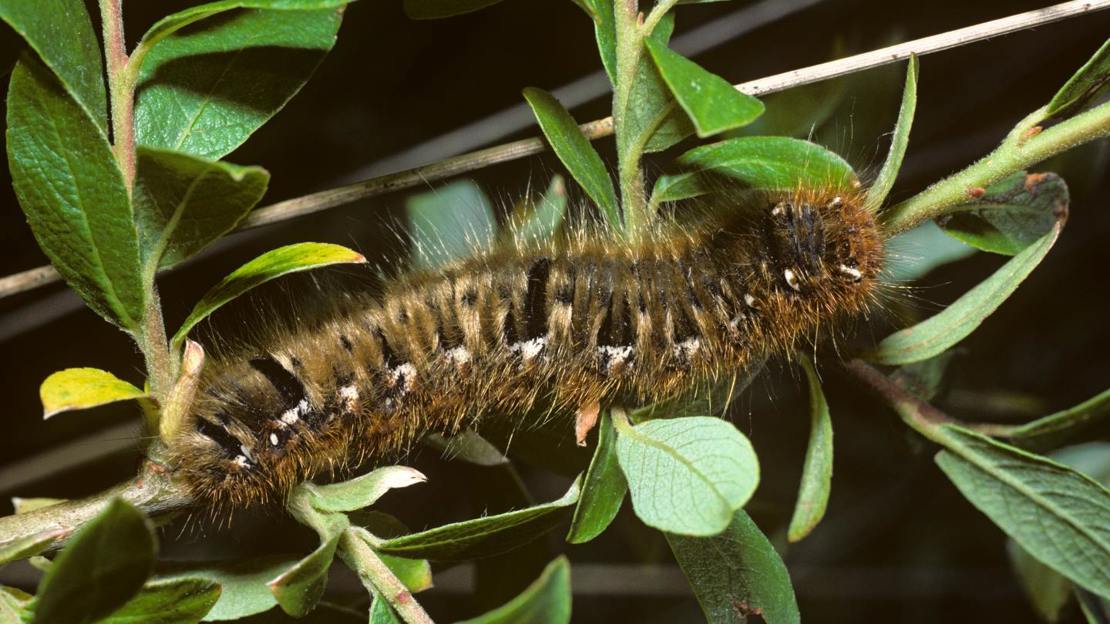
There are two forms of this moth in the UK - the oak eggar and the northern oak eggar. The adult of the latter is larger and the is female darker.
How to identify
Look for black bands separating sections of bristly brown hairs. A broken white line also runs along the caterpillar's sides with a row of small white spots beneath.
Size
Up to 75mm in length when fully grown.
When to see it
Look out for this caterpillar between April and July when it emerges from dormancy.
Where to find it
Widespread and fairly common across the UK. Mainly found on heathland and moorland but also woodland edges, scrubland, fens and grassy habitats.
Foodplants
Don't be fooled by the name - this caterpillar doesn't actually feed on oak (the name instead refers to the pupae which look a bit like acorns). Instead it eats heather, bramble, hawthorn, blackthorn, sallows, bilberry, hazel and other shrubs.
4. Small eggar moth caterpillar (Eriogaster lanestris)
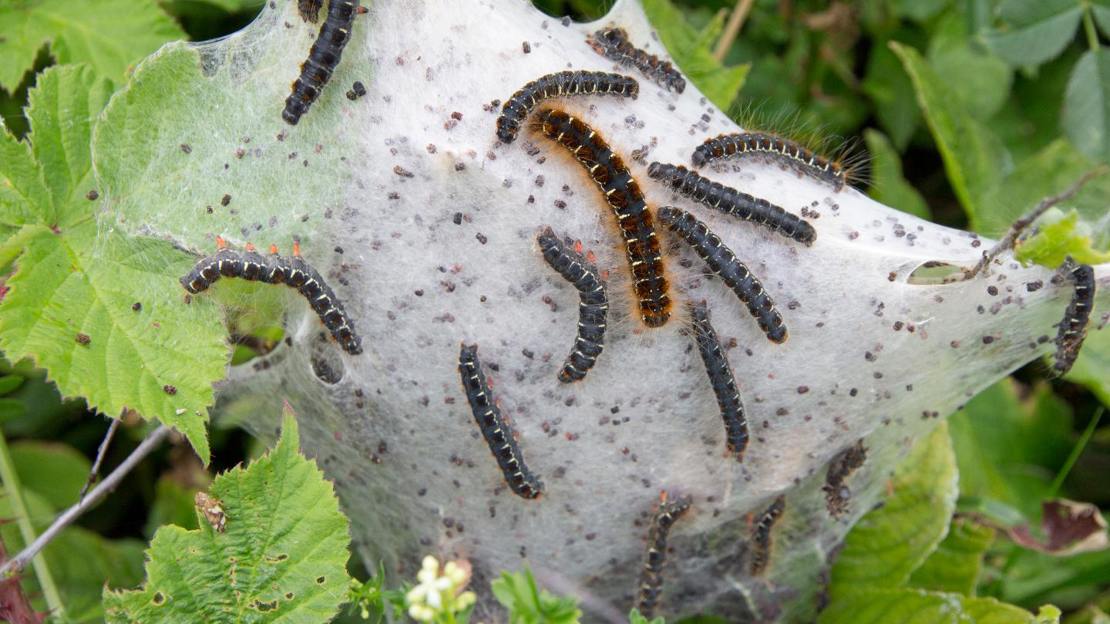
How to identify
Patches of chestnut brown hairs band this caterpillar's body, each with creamy lines bordering it. When young the body appears more of a slate grey. The dead giveaway is the silky tents the caterpillars live in together as they grow.
Size
Up to 45mm in length when fully grown.
When to see it
Look out for groups of these caterpillars from April to July, especially in warm weather when they bask in the sun.
Where to find it
Once common but now fairly scarce in many parts of the UK. It is found mainly in parts of south, central and eastern England, with some populations further north and in Wales. Look for it in hedgerows.
Foodplants
Mainly hawthorn and blackthorn.
5. Lackey moth caterpillar (Malacosoma neustria)
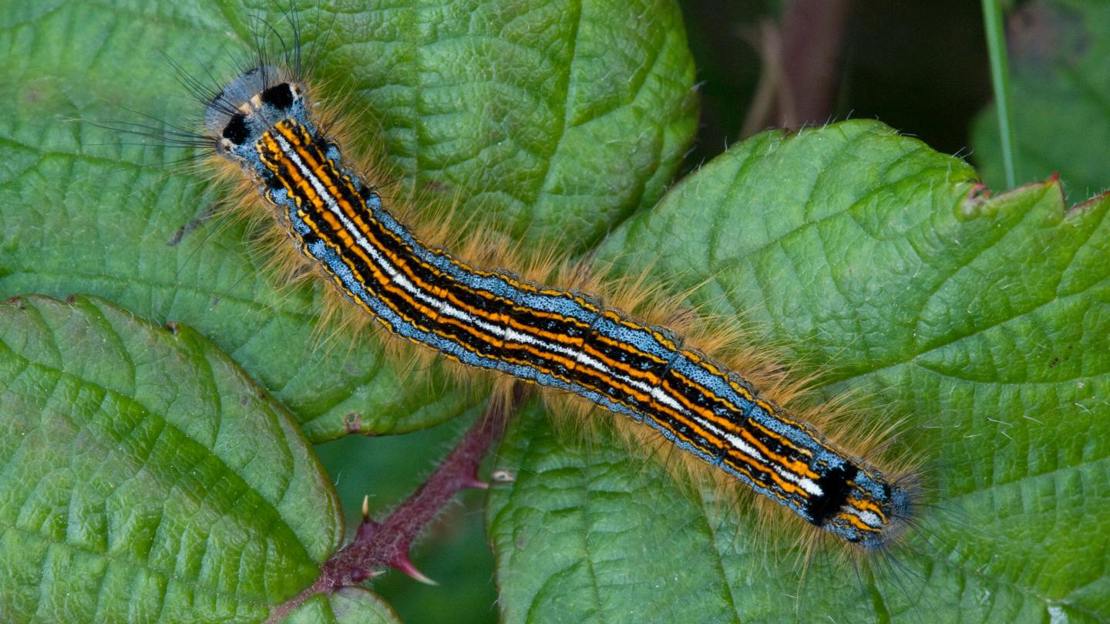
How to identify
This is another caterpillar that lives together in groups while young on a silky web. It should be fairly easy to distinguish from other hairy caterpillars thanks to its bright orange, black and white stripes which run lengthwise along its back. The hairs protrude from the sides of its blue body beneath a yellow stripe.
Size
Up to 45mm in length when fully grown.
When to see it
Look out for this caterpillar between April and June.
Where to find it
Common across south, central and parts of northern England as well as southern and western Wales. Found in gardens, hedges and woodlands.
Foodplants
Mainly hawthorn and blackthorn but also other deciduous trees and shrubs.
6. Drinker moth caterpillar (Euthrix potatoria)
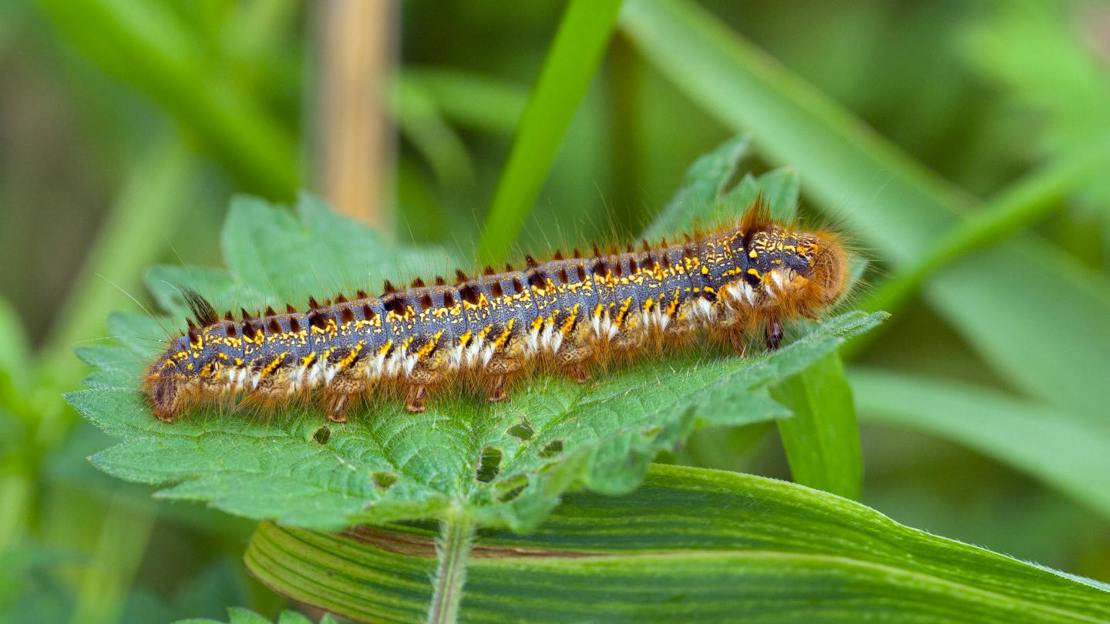
How to identify
Has a grey body speckled with yellow and covered in brown tufts of hair. When more mature it also has two horn-like tufts of hair at either end. The sides have patches of lighter hair running along them.
Size
Up to 75mm in length when fully grown.
When to see it
Can be spotted when young in late summer before hibernation, then as a mature caterpillar in spring before pupation around June.
Where to find it
Most common in southern England and Wales but also found across parts of the north of England, Northern Ireland and western Scotland. Found mainly in wet places such as fenland, meadows and damp woodland.
Foodplants
Various grasses and reeds which it generally feeds on at night.
7. Brown-tail moth caterpillar (Euproctis chrysorrhoea)
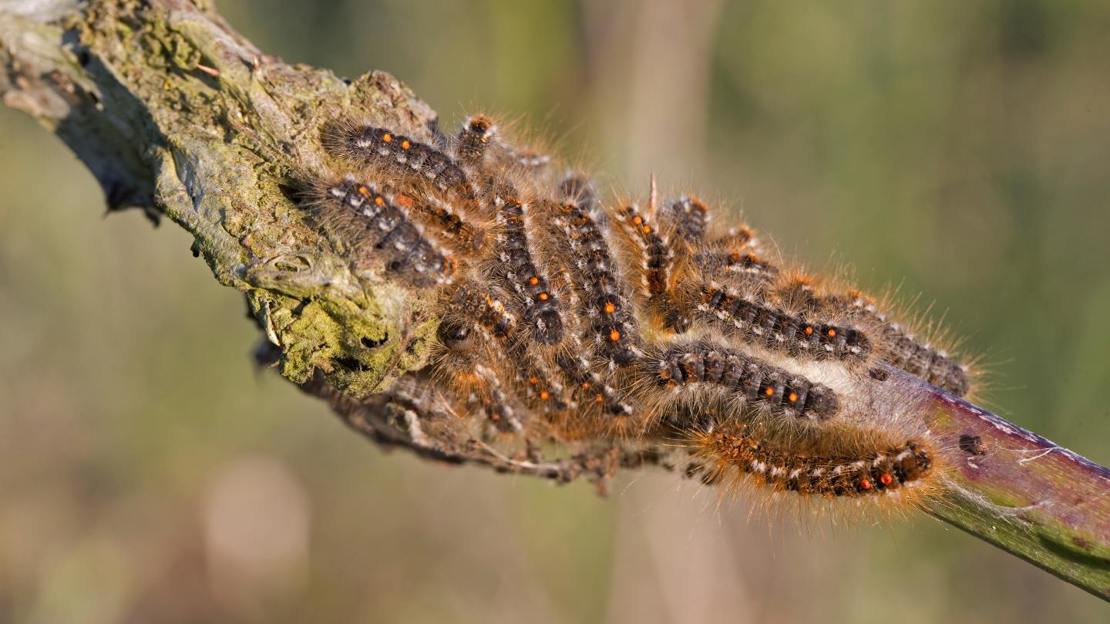
The hairs of these caterpillars can irritate the skin, much like a nettle rash. Look but don't touch.
How to identify
This caterpillar lives in groups and overwinters in silk webs. Look for a line of white hair tufts along either side of the body, each bordered by brown tufts. Two bright orange spots also appear towards the tail end as the caterpillar matures.
Size
Up to 30mm in length when fully grown.
When to see it
First appear from September after which they remain dormant until the following spring before pupation in June.
Where to find it
Common in hedgerows, scrub and gardens across the south east and parts of central England, with populations beginning to appear further north. It's thought that climate change could be responsible for a recent increase in this moth's range and for high numbers of caterpillars and their webs being recorded in some years.
Foodplants
Hawthorn, blackthorn and bramble as well as some other deciduous trees.
8. Buff ermine moth caterpillar (Spilarctia luteum)
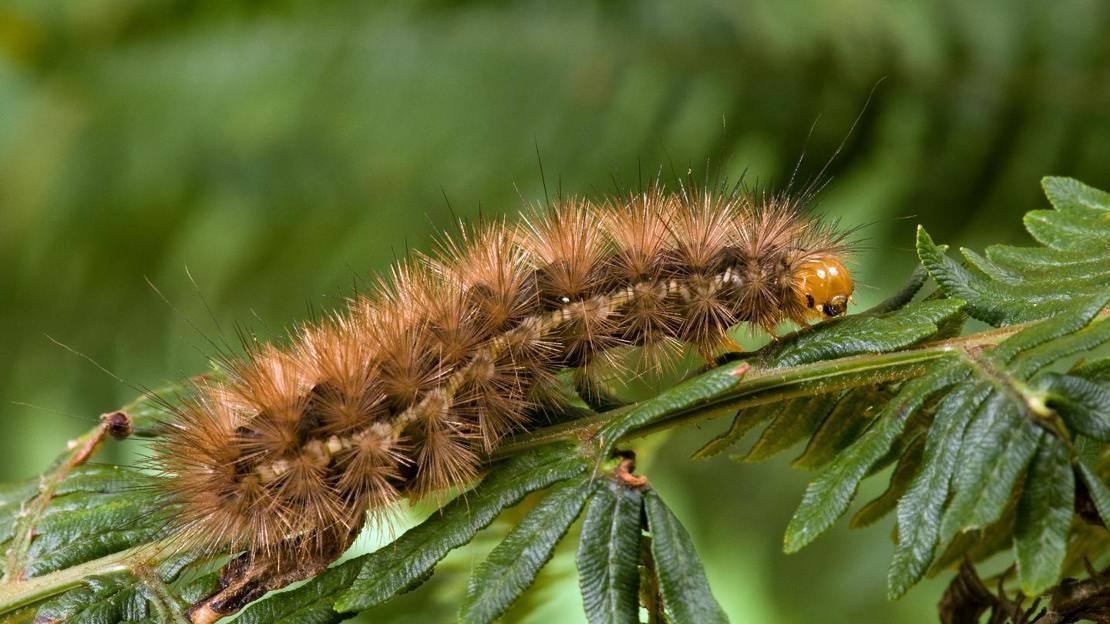
The buff ermine is one of only a few caterpillars in the UK that can feed on bracken.
How to identify
When mature this caterpillar has gingery, spiny hairs across its body and a creamy stripe running along either side. A thinner, yellow stripe is also sometimes visible running along its back.
Size
Up to 45mm in length when fully grown.
When to see it
Caterpillars are active from July to October and most often spotted in autumn.
Where to find it
Common and widespread across England, Wales and Northern Ireland but restricted to mainly western parts of Scotland. Found in a number of habitats including parks and gardens, woodland and hedgerows.
Foodplants
Birch, honeysuckle, hop, nettles, docks, dandelion and various other herbaceous plants.
Want to brush up on your ID skills?
Take a look at our range of wildlife swatch books for help with birds, butterflies and more.
Shop now9. White ermine moth caterpillar (Spilosoma lubricipeda)
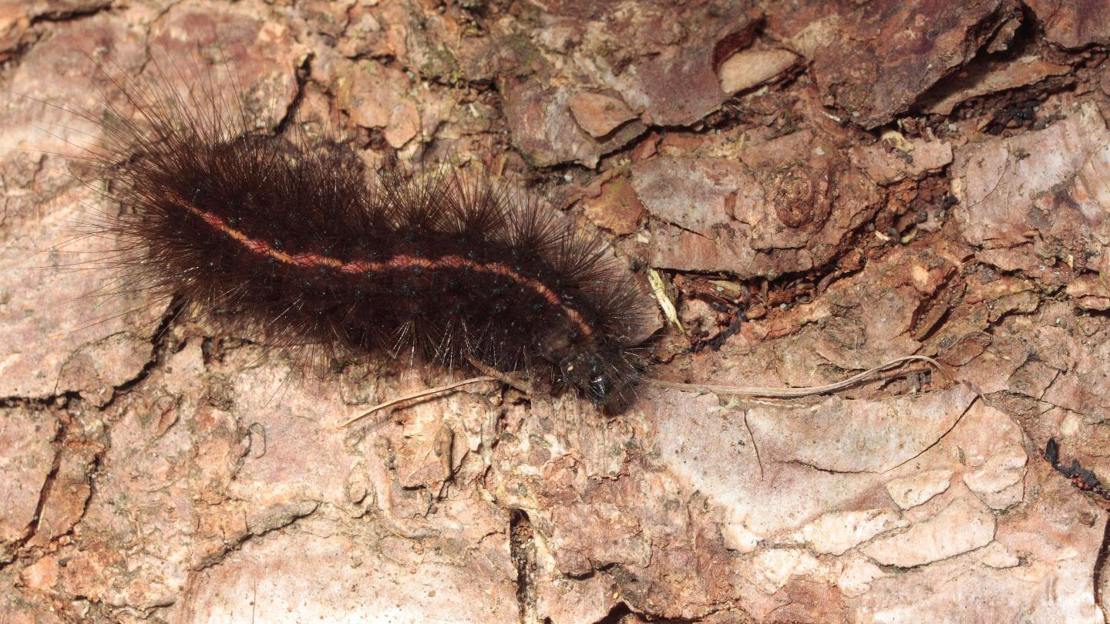
How to identify
Mostly black with spiny hairs and a distinctive reddish, orange or creamy line running along its back. It is also known for being quick on its feet and can be rather speedy when moving to new ground.
Size
Up to 40mm in length when fully grown.
When to see it
Look for this caterpillar between July and September.
Where to find it
Common and widespread across the UK. Found in almost all habitats including gardens and woodland.
Foodplants
Docks, nettles and other low-growing herbaceous plants.
10. Muslin moth caterpillar (Diaphora mendica)
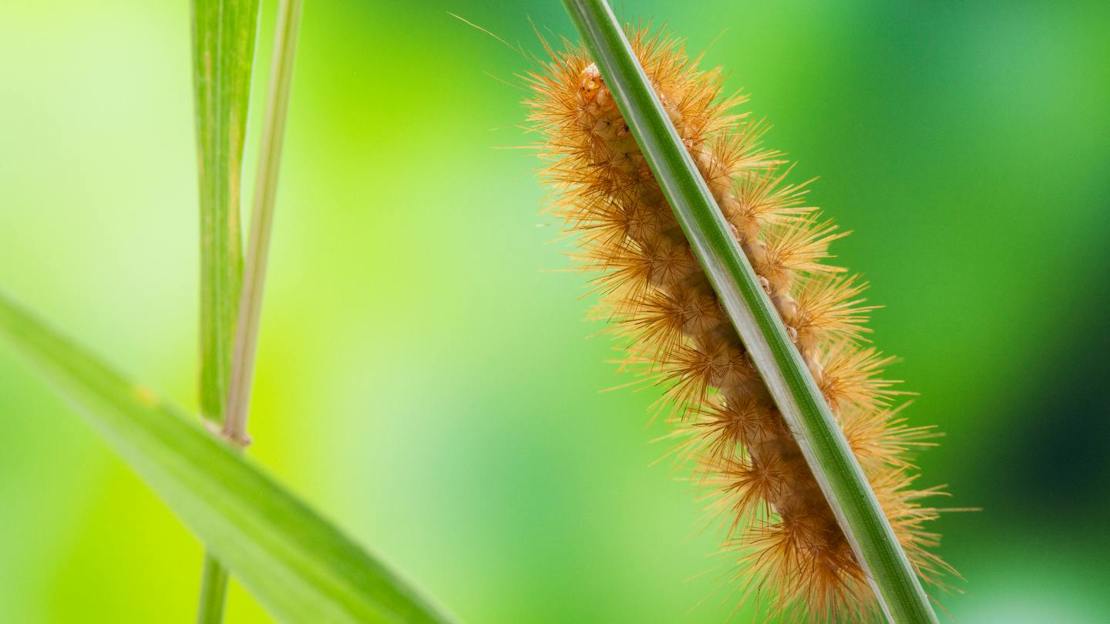
How to identify
A rather dumpy-looking caterpillar with sprouts of spiny, ginger hairs all over. The body beneath is greyish. When threatened it rolls itself into a curl.
Size
Up to 35mm in length when fully grown.
When to see it
The caterpillar is active from July to September, then overwinters as a pupa.
Where to find it
Common and widespread across England, Wales and Northern Ireland but more scarce in Scotland. Found in open habitats, woodland, hedgerows and gardens.
Foodplants
Feeds on docks, chickweed, dandelion, heather and plantains, mainly at night.
11. Knot grass moth caterpillar (Acronicta rumicis)
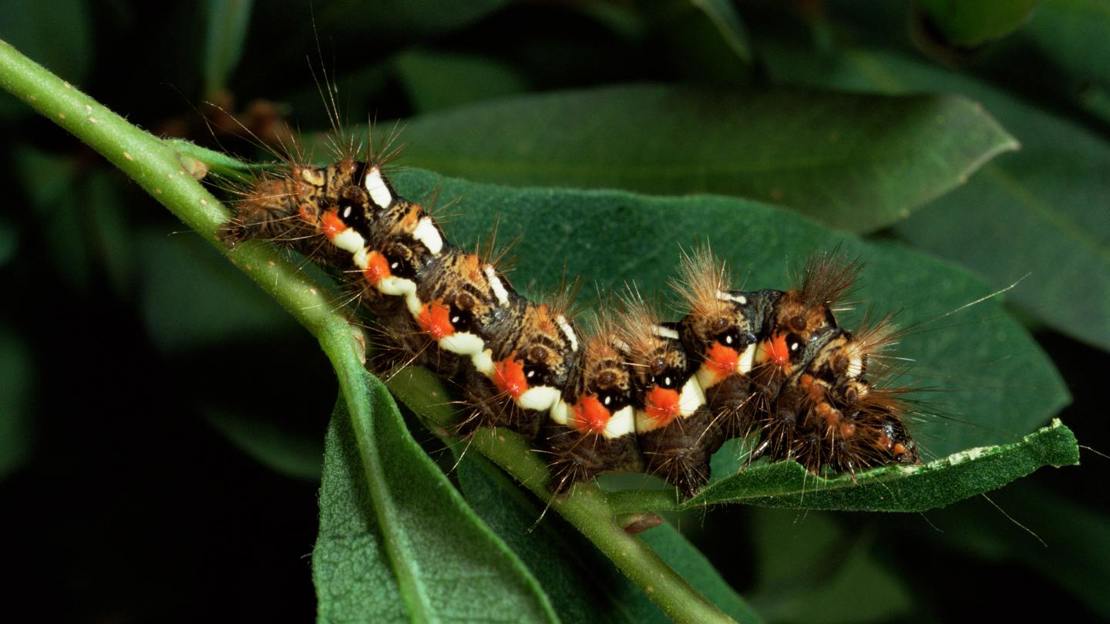
How to identify
The orange and white wavy patterning along the sides give this caterpillar away. There are also white patches along its back. The body colour can range from gingery brown to black. Tufts of sparse brown hair sprout from various points along the body.
Size
Up to 40mm in length when fully grown.
When to see it
Can be seen from May to October.
Where to find it
Common and widespread across the UK in almost all habitats, including gardens and woodland.
Foodplants
Docks, plantains, teasel, water mint and other low-growing herbaceous plants, as well as some deciduous trees, such as sallows and hawthorn.
12. Yellow-tail moth caterpillar (Euproctis similis)
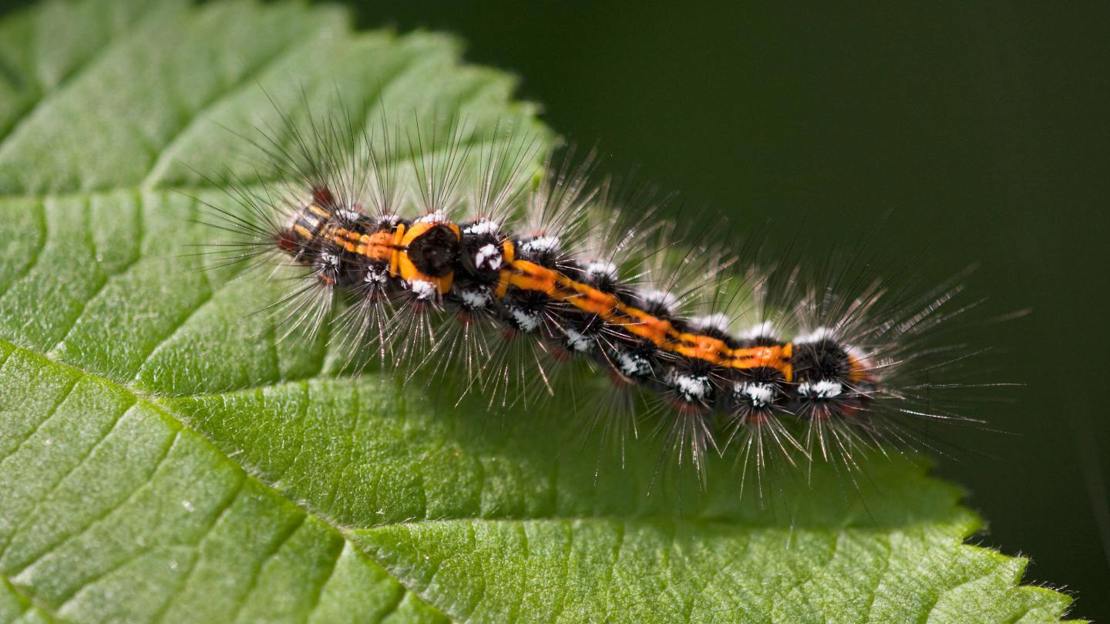
The hairs of this caterpillar can irritate the skin and should not be handled.
How to identify
Look for the distinctive red double stripe along the back and white patches sprouting tufts of hair along the sides. There are also lines of red markings along the sides. The body is otherwise black.
Size
Up to 43mm in length when fully grown.
When to see it
Look for this caterpillar in late summer before it goes into hibernation.
Where to find it
Common and widespread across most of England and Wales, with some populations in the far south of Scotland and parts of Northern Ireland. Found in gardens, woodland and scrubby habitats.
Foodplants
Hawthorn, blackthorn, oak and other deciduous trees.
13. Vapourer moth caterpillar (Orgyia antiqua)
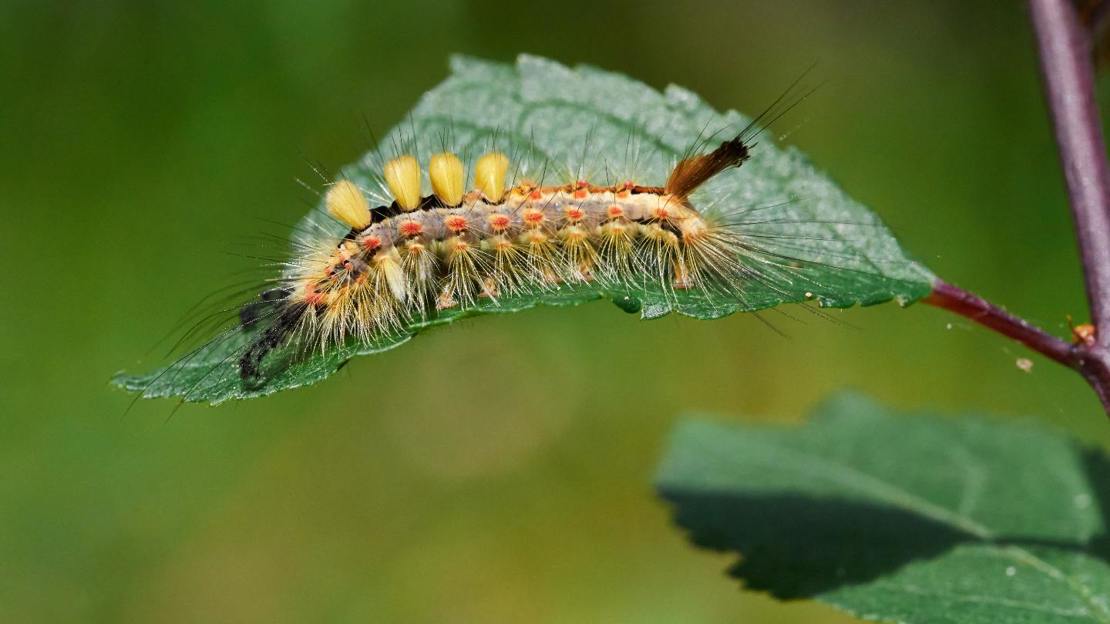
In North America this moth is known as the rusty tussock.
How to identify
The four yellow, densely-packed tufts of hairs towards this caterpillar's head end are unmistakable and often described as resembling shaving brushes. They can sometimes also be brown or white. The body is otherwise grey with rows of orange spots and yellow hairs along the sides. It also has a dark hairy 'horn' on its rear end and two more protruding above its head.
Size
Up to 40mm in length when fully grown.
When to see it
Look for this caterpillar from May to August.
Where to find it
Widespread across all of the UK, although most common in England. Found in woodland, hedgerows and heathland as well as parks, gardens and urban areas, including on street trees.
Foodplants
A range of deciduous trees and shrubs including hawthorn, blackthorn, oak, elm and hazel.
14. Pale tussock moth caterpillar (Dasychira pudibunda)
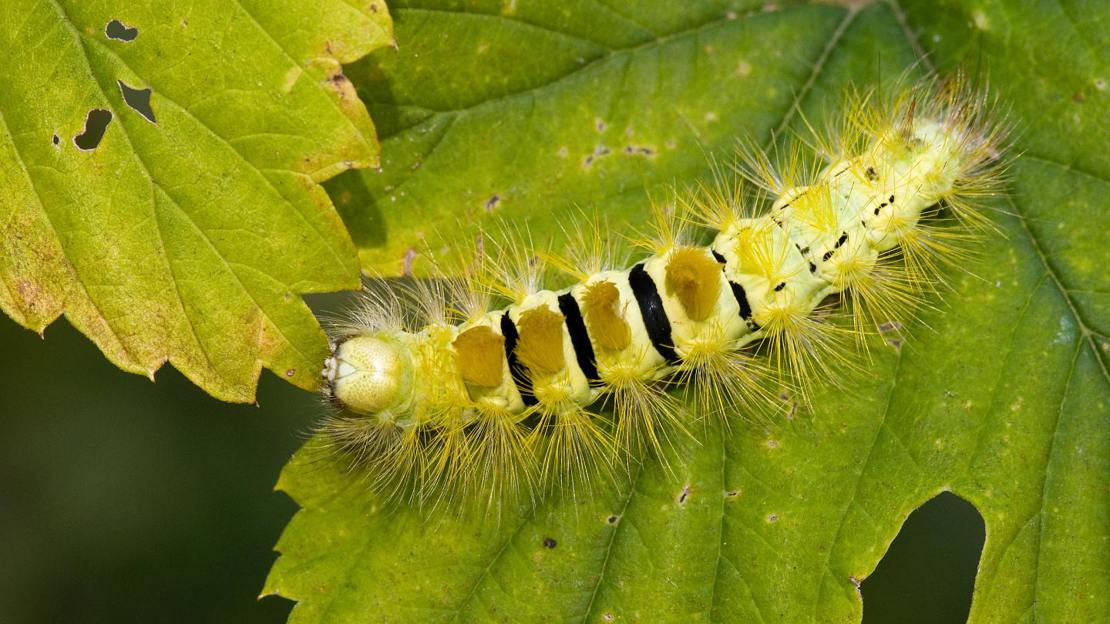
The bristles of this caterpillar can cause skin reactions if handled.
How to identify
A light green caterpillar with yellow tufts of hair, including four pale 'shaving brushes' towards the head end separated by black patches. Some can have reddish, pink or even white bristles and most have a hairy red 'horn' on the tail.
Size
Up to 45mm in length when fully grown.
When to see it
Active from May to September, but most often seen towards the end of the season when on the move in search of a place to pupate.
Where to find it
Common and widespread across most of England and Wales. Less common in Northern Ireland and very scarce in Scotland. Found in woodland, hedgerows, scrubby habitats, parks and gardens.
Foodplants
Hop and bramble plus various deciduous trees and shrubs including hawthorn, blackthorn, hazel, oak, birch and fruit trees.
15. Sycamore moth caterpillar (Acronicta aceris)
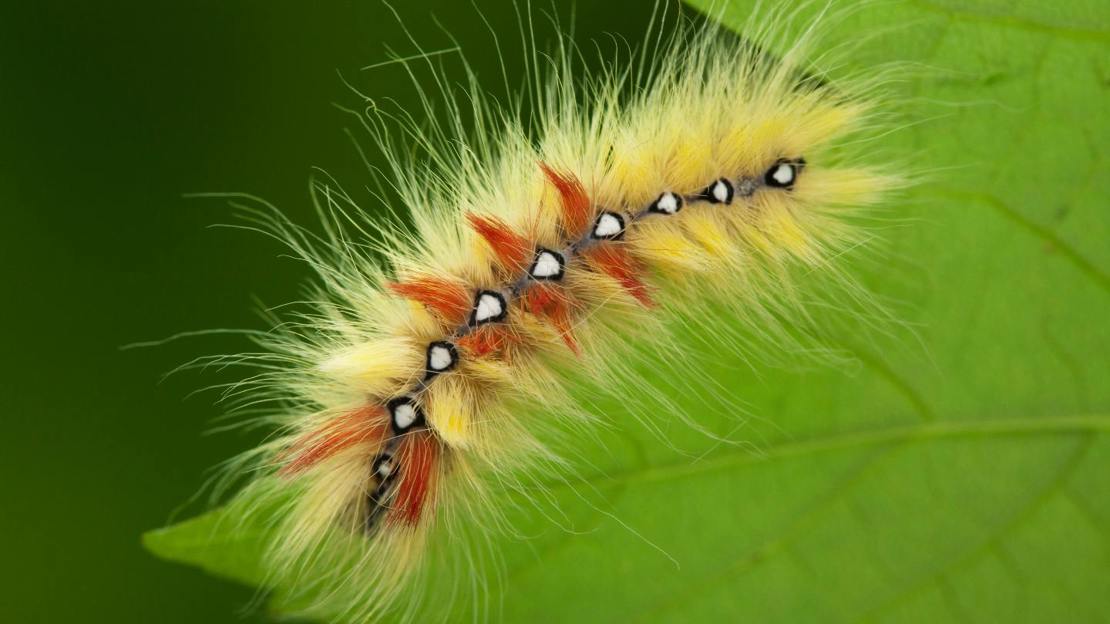
This caterpillar is one of the few in the UK to feed on horse chestnut trees.
How to identify
A colourful, fluffy caterpillar with unusual patterning that should be difficult to mistake for anything else! Look for the line of white diamonds along the back, each bordered by black. Alternating red and yellow hair tufts taper to points along the body, almost as if styled with hair products.
Size
Up to 40mm in length when fully grown.
When to see it
Most commonly encountered in late summer and autumn when they drop from trees in search of somewhere to pupate.
Where to find it
Common across the southern half of England, becoming scarce further north and towards the south west. Absent from most of Wales, Northern Ireland and Scotland. Found in parks, gardens and woodland.
Foodplants
Sycamore as the name suggests, but also field maple, horse chestnut and some other deciduous trees.
16. Miller moth caterpillar (Acronicta leporina)
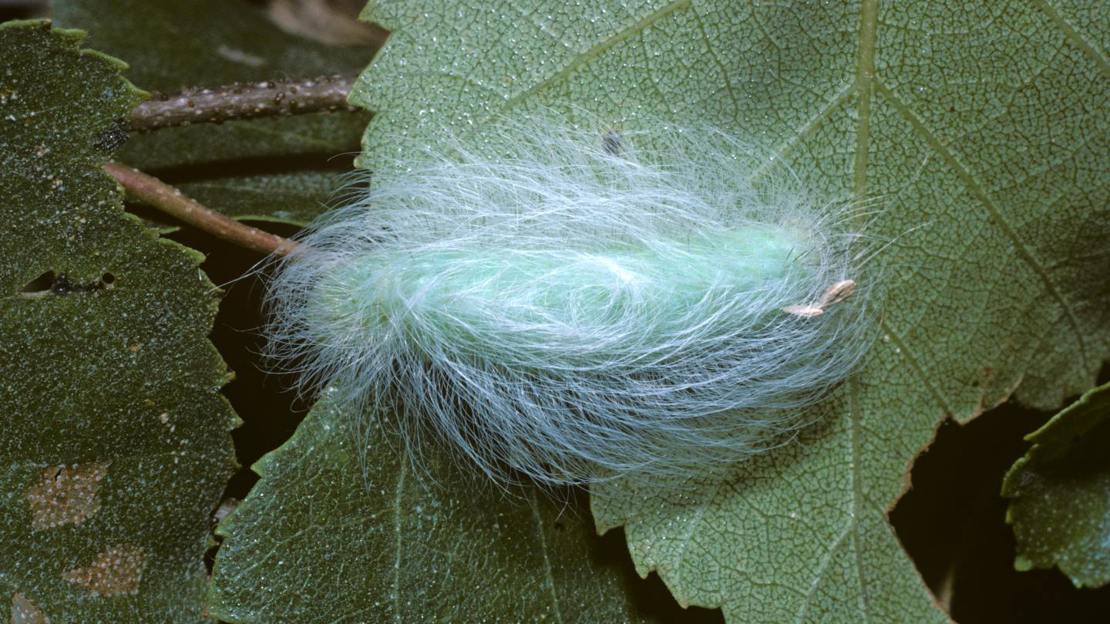
How to identify
When mature this caterpillar develops long, luxurious, slivery white hairs that sweep over and around its body. Sometimes the hairs can be yellow. The body beneath is green.
Size
Up to 35mm in length when fully grown.
When to see it
The caterpillar is active from July to October.
Where to find it
Widespread across the UK but most common in the south of England. Found in woodland and heathland.
Foodplants
Mainly alder and birch but also sometimes poplar and sallows.
Create a wildlife haven in your garden
Help support pretty pollinating insects like butterflies and moths with garden trees rich in nectar and leafy forage.
Buy treesLearn more about caterpillars, moths and butterflies
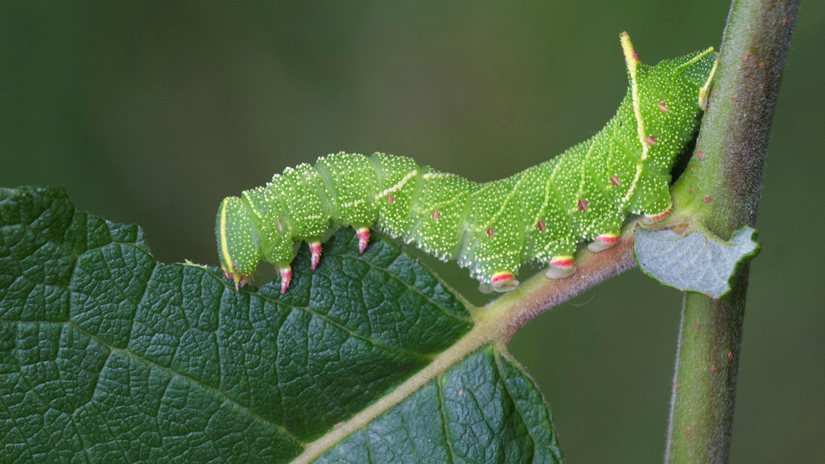
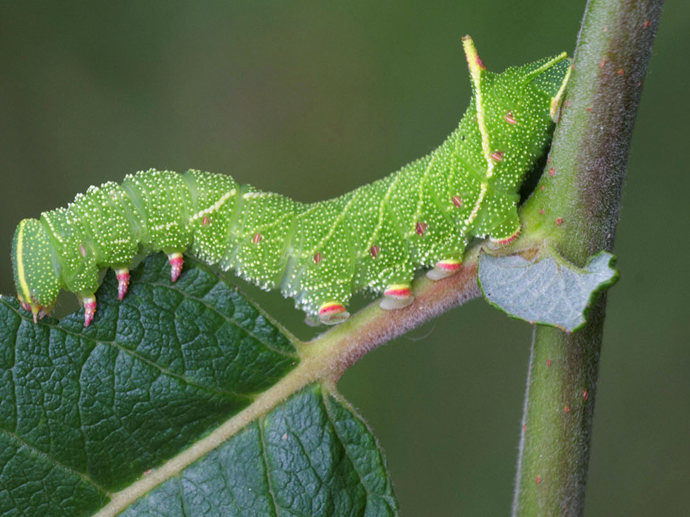
Hawk-moth caterpillar identification: eight UK species
Amy Lewis • 21 Jul 2021
Hawk-moth caterpillars have one thing in common: they're pretty impressive. Usually large, distinctively marked and with a characteristic horn at the tail end, they're a good group to get to grips with when learning who's who.


